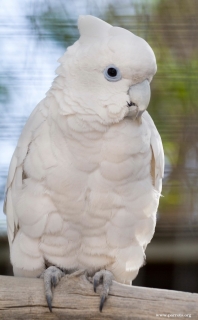Ducorp’s Corella |
|
|
Also known as: Solomon Islands Cockatoo, Solomons Cockatoo, Ducorp's Cockatoo, Broad-crested Corella
Photos
View in GalleryDid You Know?
The Ducorps Corella is the only cockatoo in its range.Academic Research
Related publications: Cacatua ducorpsiiSpecies Profile
Genus: Cacatua | Species: ducorpsii
Size:
31cm (12.1 in)
Weight:
290-415g (10.1-14.5 oz)
Subspecies including nominate:
one
Colour Adult:
Both adults small, white cockatoo with short upper mandible; pink wash on bases of feathers on head, brighter on cheeks, sometimes extending to breast; bare blue eye ring. Eye brown in male, red/brown in female.
Colour Juvenile:
As in adult but with dark grey eye.
Call:
Harsh and somewhat screechy; screech can be continuous and resemble Little Corella.
Listen NowVideo Links:
Video 1More Information:
Content Sources:
CITES
BirdLife International
Cornell Lab of Ornithology/Birds of the World
A Guide to Parrots of the World, Juniper and Parr, 1998
Parrots of the World, Forshaw and Cooper, 1977.
Lexicon of Parrots, Thomas Arndt.
Parrots of the World, Forshaw, 2006.
Parrots in Aviculture, Low, 1992.
Photos
View in GalleryDid You Know?
The Ducorps Corella is the only cockatoo in its range.Academic Research
Related publications: Cacatua ducorpsiiSpecies Care
Captive Status:
Rare
Longevity:
Not recorded.
Housing:
Walk-in enclosure or aviary, minimum length 4.5m (14.8 ft).
Diet:
Mix of small seeds: canary, oats, safflower and spray millet; limited sunflower seed, dry, soaked or sprouted; sprouted beans, cooked butterbeans and lentils; green leaves such as Swiss chard, lettuce, sowthistle, dandelion, chickweed; vegetable such as: corn, carrot, celery, zucchini, squash, green beans and peas in the pod; fruit such as: apple, pear, orange, banana, cactus fruits and others; nuts: walnuts, hazelnuts, pecans and roasted peanuts; complete pellet.
Enrichment:
Unknown, although reported to be playful and good at escaping their enclosures.
Nest Box Size:
12"x 20" (30.5cm x 51cm) box; difficult to breed.
Clutch Size:
2 to 3
Incubation Time:
26-28 days
Fledging Age:
9 weeks, usually one chick only.
Hatch Weight:
Not recorded.
Peak Weight:
Not recorded.
Weaning Weight:
Not recorded.
Photos
View in GalleryDid You Know?
The Ducorps Corella is the only cockatoo in its range.Academic Research
Related publications: Cacatua ducorpsiiSpecies Wild Status
World Population:
Unknown, stable.
IUCN Red List Status:
Least Concern
CITES Listing:
Appendix II
Threat Summary:
The species has not been subjected to heavy trapping for trade. Information is lacking but it still appears to be common, though likely to suffer in the future from increased logging.
Range:
Occurs in Bougainville and Buka Islands, E Papua New Guinea; and Solomon Islands east to Malaita but absent from San Cristobal group.
Habitat:
Found from coastal areas to mountains; variety of habitats including forest, forest edge, secondary growth, gardens, woodland and townships. Found up to 1700m (5576 ft); mainly below 700m (2296 ft).
Wild Diet:
Feeds on seeds, berries, fruit, buds, blossoms, epiphytes and insects and their larvae. Forages in native gardens for pawpaws and sweet potatoes.
Ecology and Behaviour:
Is noisy and visible, will fly off noisily if disturbed. Seen in pairs or small flocks flying above the treetops. Raises crest when agitated or excited. May take some garden crops (yams and pawpaws).
Clutch and Egg Size:
2 to 3 elliptical eggs, 37.5 x 26.5mm (1.5 x 1.0 in)
Breeding Season:
July-September; nests are in tree hollows.
Related Links:
Research: Molecular Systematics and Biogeography of the Cockatoos
Photos
View in GalleryDid You Know?
The Ducorps Corella is the only cockatoo in its range.Academic Research
Related publications: Cacatua ducorpsiiMembers Only Resources
Please log-in now to find more research, resources and tools.
Not a Member?
Find more great information:
Gain exclusive access to 600+ pages of additional research, seminars and podcasts, specialists to ask your toughest questions, and dozens of other fun resources - when you become a WPT member.
Join Today >>

































